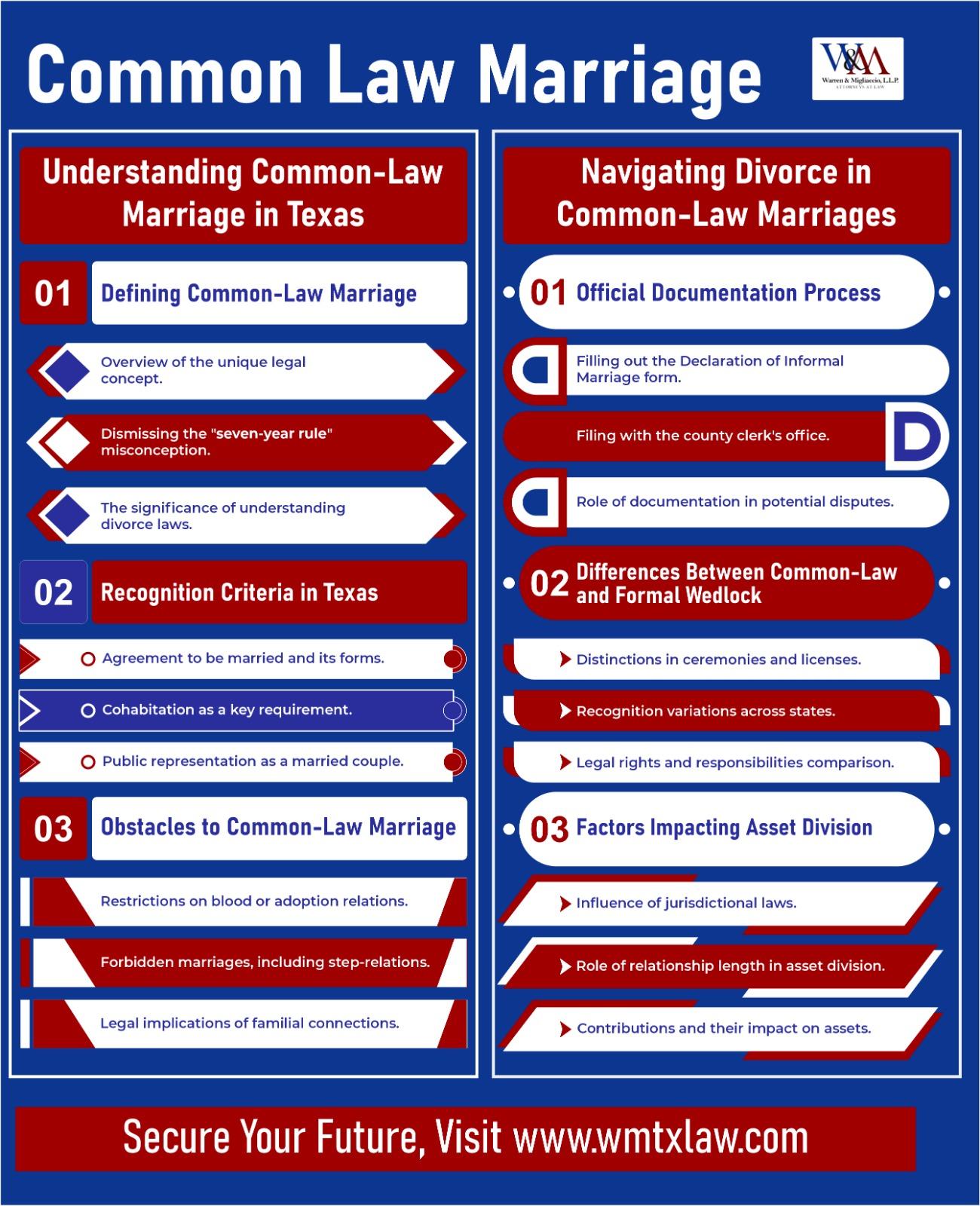
Common law marriage in Texas is a unique legal concept that allows couples to be recognized as married without having a formal ceremony or obtaining a license. Understanding the intricacies of common law marriage in Texas is crucial due to its potential legal consequences in divorce, especially since it may not always involve a formal marriage certificate or a postnuptial agreement.
A common law marriage in Texas must meet three key elements. There is no set time frame for how long a couple must cohabitate to establish a common law marriage, dispelling the myth of the “seven-year rule.” Understanding divorce laws is essential for those in common law marriages. In Texas, dissolving a common law marriage requires the same legal process as a formal one.
Texas recognizes common law or informal marriage, including same sex marriage. Under Section 2.401 of the Texas Family Code, the couple must meet specific criteria to prove common law marriage when registering at the Bureau of Vital Statistics:

The couple must not be related to one another by blood or adoption, such as as a whole or half-brother or sister. Nor may they be a full or half aunt or uncle, first cousin or a niece or nephew. They are also forbidden to marry a former stepparent or stepchild. First cousins once removed may marry, however.
To officially document your common law arrangement in Texas, the couple can fill out and sign a Declaration of Informal Marriage form and file it with the county clerk’s office, such as in Dallas County. This is not required to establish a common law marriage but can serve as evidence in future disputes.

Common law marriage and a formal one (often referred to as ceremonial or traditional) differ in several key aspects:
To enter into a formal marriage, couples must meet specific legal requirements, which typically include obtaining a marriage license, having witnesses, and complying with state laws. common law marriage, on the other hand, revolves around the couple’s conduct and intent to be joined as a couple less formally. There are no specific formal requirements.
Dissolving a formal marriage requires a legal divorce process. This includes filing divorce papers, property division, child custody arrangements (if applicable), and adhering to state laws. Dissolving a common law marriage also requires a legal divorce process with the same considerations as a formal marriage.

The division of assets and debts in a common law marriage divorce can be influenced by several factors, including the jurisdiction’s specific laws regarding property division. Unlike traditional marriages, there might not be a clear legal framework outlining the division, making it potentially more contentious and complex.
One crucial factor affecting the division of assets and debts in a common law marriage divorce is the length of the relationship. The longer a couple has been together, the more intertwined their finances are likely to be, making it difficult to determine who is entitled to what in terms of property and debts.
In addition, each party’s contributions during the relationship can also significantly influence the division of assets and debts, particularly in cases of high asset divorce where the financial stakes are higher. This includes financial contributions, such as income earned and assets acquired, and non-financial contributions, such as child-rearing and household responsibilities.
Laws can also majorly impact how assets and debts are divided in a common law marriage divorce. The law mandates that both spouses have the right to a just division of property acquired during the marriage, regardless of who paid for or owned it.
The concept of community property plays a critical role in divorce proceedings. Community property includes all assets and income acquired by either spouse during the marriage, except for certain items considered separate property, such as inheritances, personal gifts, or assets owned prior to the marriage and maintained separately.

During a Texas divorce, including a military divorce, the presumption is that all assets acquired by the couple are community property and should be divided equitably, though not necessarily equally, between the spouses. This system ensures a fair distribution based on circumstances unique to each divorce case. Additional factors considered in a Texas divorce may include each spouse’s age, health, and earning potential.
It is essential to seek legal counsel from an experienced divorce lawyer who can navigate the specific laws and circumstances of the jurisdiction where the divorce is taking place. Consulting with a family lawyer, along with maintaining open communication and cooperation between both parties, helps facilitate a smoother and fairer resolution.
Once established, common law spouses, whether a same sex couple or opposite sex, have the right to:
In cases where a surviving spouse seeks to prove a common law marriage after their partner has passed away, they may encounter difficulties in inheriting property or receiving other benefits if there is no record of their marital status. Couples must take steps to establish their common law marriage during their lifetime or obtain joint bank accounts and insurance policies.
Child custody in a common law divorce in Texas mirrors that of a traditional one, including considerations for joint custody arrangements. The main focus remains the child’s best interest, with the court considering multiple factors to determine custody arrangements. These factors include but are not limited to, the child’s age, physical and emotional needs, each parent’s ability to care for the youngster, and the current and future emotional and physical danger to the minor.

The court also assesses each parent’s stability, parenting skills, and willingness to support the child’s relationship with the other parent. Joint managing conservatorship is commonly awarded, allowing both parents to make decisions about the child’s upbringing. However, one parent may be designated as the primary custodian, determining where the child will reside. In cases where a common law marriage is not recognized, establishing paternity may be an additional legal step required for custody determinations in Texas.
Regarding inheritance in Texas, common law marriages are treated similarly to formal unions. If a common law spouse passes away without a will, the surviving spouse has the same rights to inheritance as they would in a traditional marriage. This means that the surviving common law spouse is entitled to a share of the estate, including real property and personal assets. Without clear proof of common law marriage, other family members could challenge their right to inherit under intestate succession laws. Therefore, it is always advisable for individuals in a common law marriage to have a valid will in place to ensure their wishes are honored and to provide clarity for distributing their assets after death.

The Warren & Migliaccio, L.L.P. law firm can help you when you are facing divorce in a common law marriage. Our experienced Texas divorce attorneys can help you prove the existence of your common law marriage to the court, which is a critical first step in securing your legal standing. We’ll work diligently to gather necessary evidence, such as documentation of shared finances, affidavits from witnesses, and any other pertinent information that establishes your marital relationship.
We can also help you divide property equitably, advocate for your fair share of assets and debts, and ensure recognition of your contributions to the partnership. Regarding the delicate matter of child custody, our lawyers commit to protecting your parental rights and focus on your children’s best interests, navigating the legal system to secure an arrangement that supports their well-being and your role in their lives.
Should you require spousal support, wish to pursue a collaborative divorce, or experience problems in the inheritance process, we are prepared to represent your interests vigorously. We are adept at negotiating settlements that reflect the true nature of your shared life and, when necessary, litigating on your behalf to achieve a just outcome. We aim to provide you with the peace of mind and legal expertise needed to move forward from a common law divorce with your rights intact and your future secure.
Call the law office of Warren & Migliaccio, L.L.P. at (888) 584-9614 to schedule a free case review. We will be here for you every step of the way.